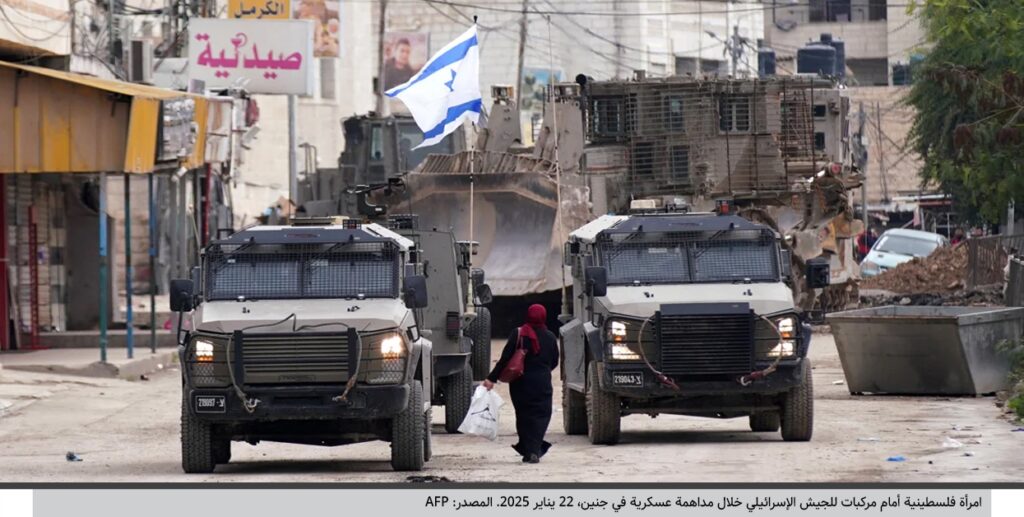
The Israeli “Iron Wall” operation in the northern West Bank comes in light of many local, regional and international developments, as it came two days after the ceasefire in the Gaza Strip came into effect. At this time, the operation raises several questions, including the possibility of expanding its scope to include various areas of the West Bank, especially after it was described by Israeli officials as part of changing the concept of security in the West Bank.
The Israeli army launched a large-scale military operation in the northern West Bank, starting from the city of Jenin and its camp, and called it “Iron Wall” on January 21, 2025, with the participation of large forces from the army, the Shin Bet, and the Border Guard, including four units from the “Kfir” Brigade and a commando unit, supported by air cover from helicopters and drones. The operation, until February 6, resulted in the killing of 44 Palestinians and the injury and arrest of dozens in the areas of Jenin, Tubas, and Tulkarm, the displacement of thousands of families from the Jenin and Tulkarm camps, and the demolition of dozens of homes and facilities, in addition to the killing of three Israeli soldiers in the Jenin camp and the Tayasir checkpoint in the northern Jordan Valley. The operation came based on a decision by the political level following a cabinet meeting on January 17. In fact, the operation at this time raises several questions, including the possibility of expanding its scope to various areas of the West Bank, especially since the Israeli Finance Minister, Bezalel Smotrich, described the operation as “part of changing the concept of security in the West Bank.”
Timing of the operation in the Israeli context
The Israeli operation comes in light of many local, regional and international developments, as it came two days after the ceasefire in the Gaza Strip came into effect on January 19, 2025, which exacerbated the differences within the Israeli government, as it was rejected by the extreme right-wing parties, and led the Israeli Minister of National Security Itamar Ben-Gvir and his party ministers to resign from the government on January 19, while Finance Minister Bezalel Smotrich preferred to remain in the government after confirming that he had obtained a commitment to “change the way of war.”
However, Ben-Gvir’s resignation strengthened Smotrich and his party’s influence in the government, especially since the withdrawal of the “Jewish Power” party is not enough to bring down the government, as long as it is not accompanied by the withdrawal of the “Religious Zionist Party” led by Smotrich. As for the latter, his policies are primarily based on the West Bank compared to the Gaza Strip, as he holds the position of the person responsible for the civil administration with the rank of minister in the Ministry of Defense, and thus the military operation in the northern West Bank is linked to the Israeli government’s orientations towards the West Bank. The Israeli Broadcasting Authority reported in mid-January that Netanyahu offered Smotrich and Ben-Gvir to build and expand settlements in the West Bank in exchange for accepting a ceasefire agreement in the Gaza Strip.
The operation also comes in light of escalating Israeli rhetoric towards the West Bank, especially by Finance Minister Smotrich, who promised in November 2024 that 2025 would be the year of “annexation of the West Bank,” and in December 2024 revealed a series of measures to annex 60% of the West Bank to Israeli sovereignty, including imposing sovereignty on the settlements first, before completing it on the rest of the West Bank, as well as closing the occupation’s “Civil Administration” unit in the West Bank.
The complex field reality in the West Bank
Since the outbreak of the war in the Gaza Strip on October 7, 2023, the West Bank has maintained a state of “controlled escalation”, compared to the pace of escalation witnessed in other secondary arenas, despite repeated attempts by Hamas and Islamic Jihad to escalate the intensity of clashes there, in addition to Iran and Hezbollah’s efforts to support armed groups militarily, considering the West Bank a “strategic” arena of activity in confronting Israel. The incursions and clashes there remained below the level that would require it to be transformed into a major “war front”, similar to the subsequent transformations on the Lebanese front .
However, the West Bank suffers from a very complex, intertwined and fragile security reality. The current operation comes after a security campaign carried out by the Palestinian Authority on December 5, 2024 in the Jenin camp under the name of “Protecting the Homeland” and lasting 47 days. The Authority described it as part of efforts to “restore law and order” in the camp after it witnessed an escalation in the activity of armed groups, especially the “ Jenin Battalion ” affiliated with the Islamic Jihad Movement. Operation “Iron Wall” is also considered a continuation of a series of previous Israeli military operations, including Operation “ Summer Camps ” in August 2024, which targeted large areas of the northern West Bank. It was preceded by Operation “House and Garden” in July 2023, and Operation “Breaking the Waves” against armed groups in the West Bank in 2022.
But given the context and timing of the current operation, there is reason to believe that it is different from its predecessors, as it comes after the end of the war in Lebanon on November 27, 2024, days after a ceasefire agreement came into effect in the Gaza Strip , the start of the exchange of Israeli detainees in the Gaza Strip for a number of Palestinian prisoners in Israeli prisons, and finally the inauguration of US President Donald Trump , some of whose administration officials reiterate their support for the annexation of the West Bank to Israeli sovereignty, and whose first executive decisions included lifting the ban on settlers accused of committing crimes against human rights.
These circumstances place the current operation at the intersection of short- and medium-term goals. On the one hand, there is Israeli fear that the release of Palestinian prisoners will encourage individual operations and armed actions, especially since the largest number of prisoners scheduled to be released are from the West Bank. On the other hand, the operation coincides with escalating Israeli rhetoric regarding the annexation of Area C in the West Bank, and it is likely that the operation aims to deter any factors that could lead to an explosion of the situation in the West Bank.
What’s next after the “iron wall”?
The Israeli discourse includes indications and meanings that the ongoing military operation may not be limited to specific areas in the northern West Bank, and may extend to various areas of the West Bank. Israeli Prime Minister Benjamin Netanyahu stated that the goal of the operation is to “uproot terrorism in the entire region,” and that it is “broad and important.” Defense Minister Yisrael Katz announced that the operation “will continue for months.” This discourse is met with field measures that reinforce the validity of the breadth and depth of the operation, including:
First: The Israeli army gave the operation a name, indicating that what is happening goes beyond the issue of repeated incursions or raids, and that there are military objectives that the army seeks to achieve, similar to what happened in the Gaza Strip, where the war was called “ Iron Swords ,” and the military operation in Lebanon was called “ Arrows of the North .” It is likely that Israel is planning to change the reality on the ground in the West Bank, similar to its experience in Lebanon and the Gaza Strip, and to limit infiltration operations into settlements and inside Israeli cities, which is what the name given to it suggests.
Second : The operation was accompanied by unprecedented field measures, including tightening the closure of various towns and cities in the West Bank, doubling the number of iron gates and earth mounds at the entrances to those towns and cities, and creating new checkpoints and checkpoints throughout the West Bank. Data from the “Wall and Settlement Resistance Commission” indicate that the number of checkpoints and gates set up by the army in the West Bank reached 898 military checkpoints in total.
Third : The Israeli army is following different military strategies than those it followed during its previous operations in Jenin and the West Bank. Defense Minister Yisrael Katz stated that the army is applying the lessons learned from the operations in the Gaza Strip, and UNRWA revealed that Israel is using advanced weapons in its operation in Jenin.
The separation and division of the West Bank indicate that the military operation is heading towards being more focused compared to the “summer camps” operation that was launched in three main areas: Tulkarm, Jenin and Tubas, by intensifying and concentrating the operations in a specific geographical area, currently Jenin, Tubas and Tulkarm , before moving and expanding to another area; in a manner that appears similar to the tactics of the Israeli army on the ground in the Gaza Strip.
Fourth : Various areas of the West Bank are witnessing extensive and intensive arrest campaigns, with field investigations being carried out. For the first time, the Israeli army is using white clothing for detainees in Jenin and its camp, similar to the one it used in the Gaza Strip, in an apparent reference to the same classification of detainees, and the transfer of the war from the Gaza Strip to the West Bank.
Fifth : The number of attacks carried out by settlers against Palestinians has increased. According to the newspaper Haaretz, the Israeli security establishment is monitoring an increase in settler attacks after the ceasefire agreement in the Gaza Strip, such as the attacks on the villages of Al-Funduq and Jinsafut, east of Qalqilya in the West Bank, which were followed by more than fifty settlers storming the two villages and setting fire to buildings and vehicles on January 20, 2025. Some link the increase in settler violence to the decision of the Israeli Defense Minister to cancel administrative detention orders issued against settlers who carried out attacks in the occupied West Bank on January 17, considering it a “green light” for the settlers.
Finally , whether the current military operation stops within its current borders or expands beyond that, it is unlikely to constitute a security decision in the West Bank, or change the facts on the ground there, as much as the operation appears to be part of the policies of “permanent aggravation” of the field situation on the part of the Israeli far-right government, considering that aggravation as the price for the survival of that government, and a guarantee against its collapse. It does not seem that Israel is in a position that allows it to enter into a new, comprehensive front as happened in the Gaza Strip, especially in light of the need of society, economy, and army in it to recover from the war in the Strip.
